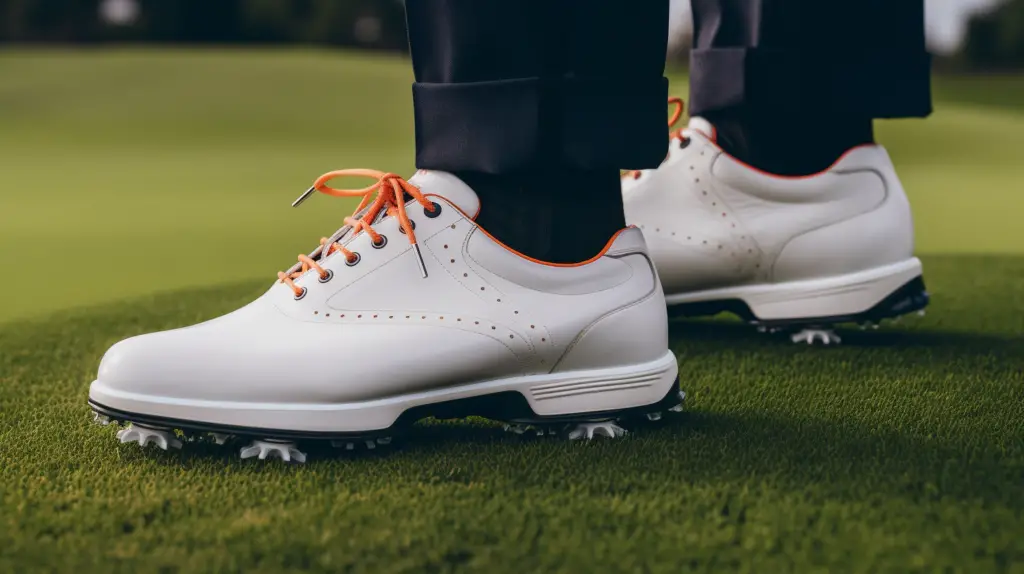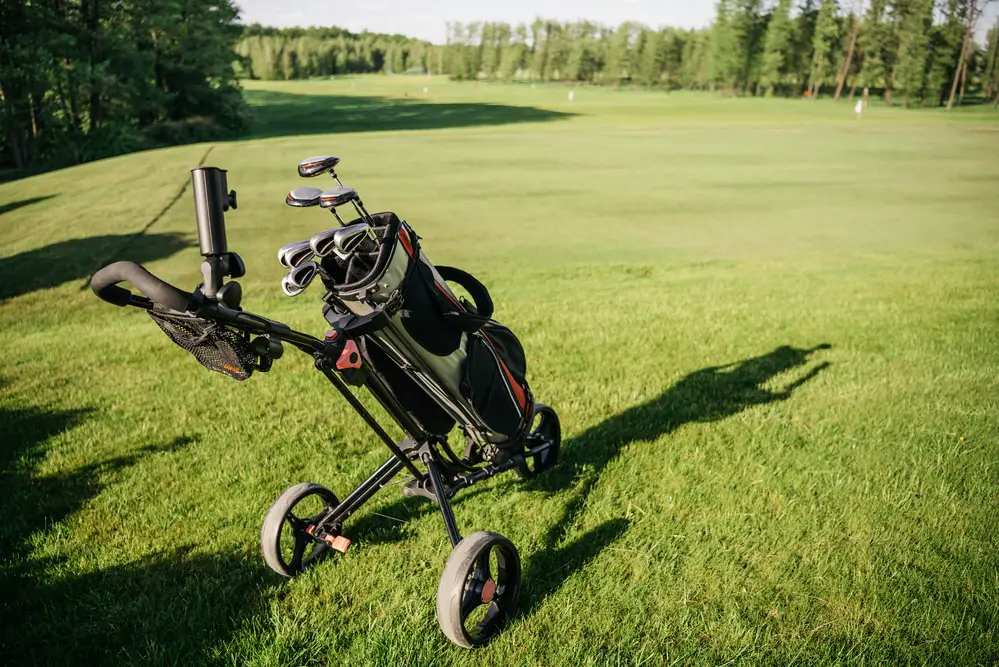Last Updated on October 23, 2023
Golf is a sport that requires precision and skill. The right equipment can make the difference in an individual’s performance on the golf course. One important piece of equipment is a good pair of golf shoes. Golf shoes are designed to provide traction and stability, so why do they have spikes? The purpose behind these spikes and how they improve one’s game.
History of Golf Shoes
Golfing footwear has evolved significantly since its inception. In the early days of golf, players would wear shoes made from leather with metal spikes or cleats to help provide better traction on the course. This was necessary due to the turf and terrain being uneven and slippery in many places. However, as time progressed and technology improved, so too did the materials used to make golf shoes; eventually transitioning into modern-day designs that are lightweight yet durable enough for use in all conditions.
Spikes can be traced back to 1891 when Charles Goodyear Jr., the son of the famous inventor Charles Goodyear, filed a patent for spiked golf shoe soles. From this point onward, various modifications were made over the years leading up to today’s popular spikeless golf shoes, which have become increasingly popular among professional and amateur players alike. Spikeless models offer more versatility than their traditional predecessors while still providing adequate traction on most terrains encountered on a typical golf course. The combination of comfortability, convenience and reliability makes them an ideal choice for those looking for performance without sacrificing style.
Types of Spikes
Golf shoes commonly feature either spikes or spikeless soles. Cleated golf shoes are designed with metal and/or plastic spikes which provide the wearer with better traction on the course. Depending on the type of surface, various types of spikes may be used to ensure grip and stability during swings. For example, soft spikes made from rubber material can be used on wet surfaces, while harder spiked models can offer increased friction for dry ground. Spikeless golf shoes also exist, and they are primarily constructed using materials such as polyurethane or thermoplastic elastomer (TPE). This type of shoe provides a more comfortable fit as well as improved flexibility since there is no need to replace worn-out cleats. Ultimately, both cleated or spikeless golf shoes offer their own unique benefits depending on an individual’s preference and the playing conditions encountered at each course.
Pros and Cons of Wearing Shoes With Spikes
Golf shoes with spikes have become increasingly popular as professional and amateur golfers alike seek to improve their swings. Spikes provide greater traction on the course, allowing for more stability during a swing. They also offer additional comfort and support for walking around the green. While there are many advantages of wearing spiked shoes, it is important to consider both pros and cons before investing in them.
The Pros:
- Improved Traction: Wearing spike shoes can help you maintain your balance while swinging by providing much-needed grip on slick surfaces such as wet grass or sand traps.
- Increased Comfort: Shoes with spikes allow for better arch support which minimises fatigue when walking long distances between holes.
- Increased Stability: The increased traction offered by spikes helps reduce slips and falls that could potentially cause injuries on the golf course.
- Better Performance: With enhanced stability comes improved performance; spike shoes enable players to transfer power from the ground up through each stroke resulting in better ball control and accuracy.
On the other hand, some drawbacks should be taken into consideration when considering whether or not to purchase spike shoes. Disadvantages include an increase in noise levels due to metal-on-metal contact, dirt buildup within the grooves of the cleat, causing discomfort if left unchecked, extra weight due to added materials used in construction, and possible damage caused to greens from aggressive digging of spikes into soft turfgrass areas.
Overall, it is important to weigh all potential benefits against any potential risks associated with using spike shoes while playing golf so that you can make an informed decision based on what works best for your individual needs.
Impact on Game Performance

The use of spikes on golf shoes is important to a golfer’s game performance. The spikes provide the necessary traction and stability needed during a swing, helping with balance and foot placement while allowing for a more optimum transfer of power from backswing to downswing. As such, golfers wearing spiked shoes can experience improved swing mechanics, which leads to an increase in accuracy and distance off the tee. Additionally, these enhanced mechanics can result in lower scores and handicaps over time. Furthermore, better control of the club head through impact helps generate straighter drives that are less prone to going offline due to poor contact between turf and soleplate. Thus, by providing grip for efficient movement throughout the entire swing sequence, golf shoes with spikes help enhance game performance overall.
Frequently Asked Questions
What Is the Best Material for Golf Shoes With Spikes?
When it comes to golf shoes with spikes, the material used is an important factor in durability. Different materials offer different levels of comfort and performance as well as spike durability. Golf shoe material needs to be able to withstand wear and tear while also providing a grip on the course to ensure maximum stability during play.
The best material for golf shoes with spikes will depend on personal preference and budget. Leather is often seen as the ideal choice due to its breathability and flexibility; however, synthetic materials such as mesh or microfibers are becoming more popular due to their lightweight qualities and price point. It is important that whatever material chosen can provide good traction on all types of surfaces whilst also being able to accommodate the addition of metal or plastic spikes without tearing or causing discomfort. Furthermore, spike material should be carefully selected based on climate conditions; stainless steel tends to work better in wetter climates, whereas titanium offers greater longevity in hotter climates.
Are There Other Types of Spikes Available for Golf Shoes?
Golf shoes with spikes provide necessary traction and stability on the golf course, but there are other types of spikes available for golfers. Spikeless golf shoes use a rubberised sole to create grip and support while playing. These spikeless designs can be found in athletic or walking-style shoes, as well as traditional golf shoe styles. The rubberised material provides all-weather performance that prevents slipping during play, regardless of weather conditions. Additionally, these soles are designed to last longer than spiked versions because they don’t become worn down by regular play or wear out after long periods of time.
Rubberised soles also offer increased comfort when compared to spiked options. As the rubber is softer than metal spikes, it offers greater cushioning during swings and walks around the course. This makes them ideal for those looking for maximum comfort without sacrificing performance benefits from a spiked design. Furthermore, some top brands have created hybrid designs that combine both spike technology and rubberised materials into one comfortable package, providing an even more customised experience for each golfer’s individual needs.
Conclusion
Spikeless golf shoes are becoming increasingly popular; however, many golfers still prefer traditional spiked models. Spike designs vary from one manufacturer to another, but the main purpose of spikes is to provide traction and prevent slipping during a swing or on slippery terrain. The material used for the spike also plays an important role in providing grip and comfort. Metal spikes are generally more durable than plastic alternatives, but they can cause damage to putting greens if not installed correctly. Rubber-based spikes tend to be quieter and less damaging while offering similar levels of performance compared to metal versions.
In terms of comfort, most brands offer cushioning technology that helps reduce fatigue over long rounds of golf. Maintenance requirements typically depend on the type of spike chosen; rubber-based options may require regular cleaning, while metal varieties should be checked periodically for wear and tear. Lastly, some manufacturers produce waterproof golf shoes with spikes, making them suitable for wetter climates or courses with dew-covered grasses. As such, it is apparent that there are numerous factors contributing towards why golf shoes have spikes – from durability and performance considerations to comfort and weatherproofing advantages.



